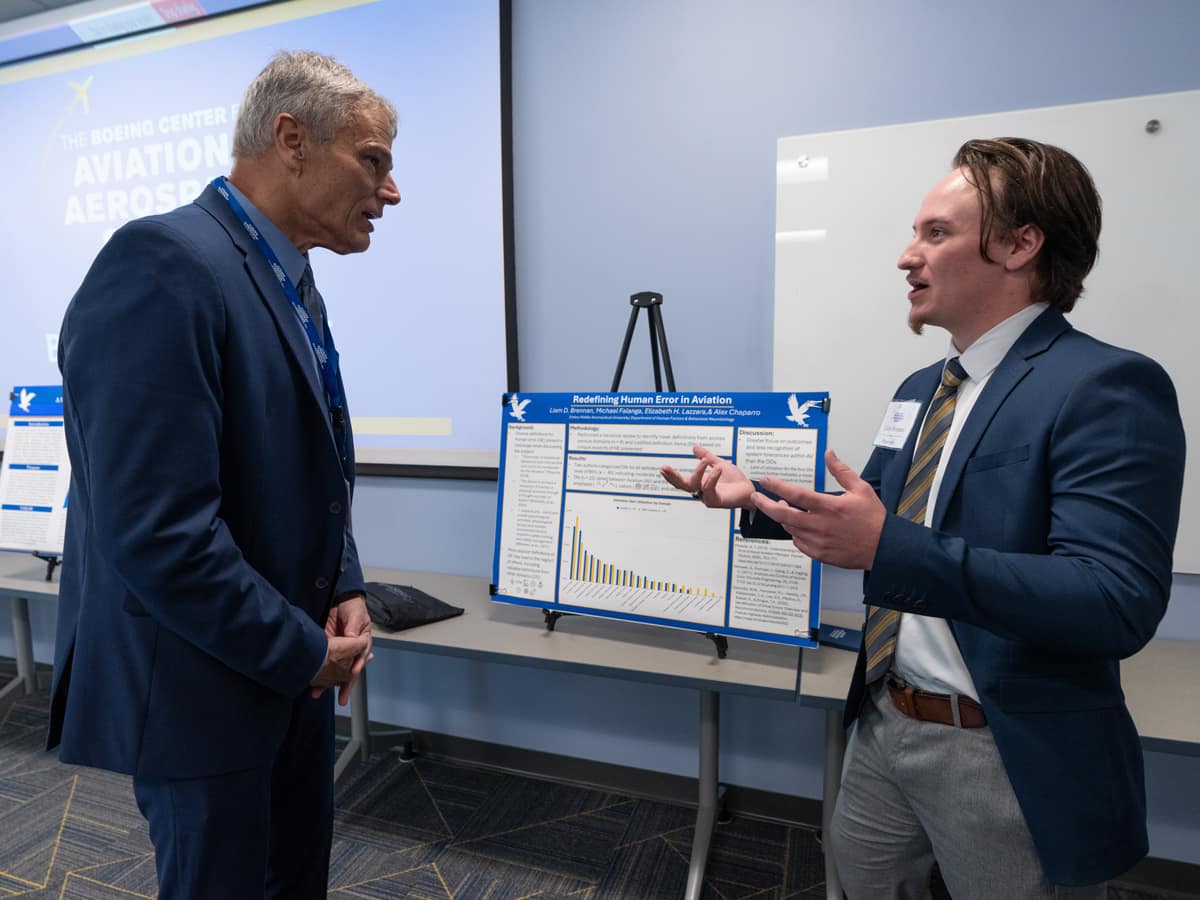The Future of Aviation Safety Presented at Embry-Riddle Research Symposium

Deep learning could help pilots avoid aircraft accidents by determining when they are disoriented, fatigued or lack the skills to execute a maneuver.
Dr. Hever Moncayo, professor and master’s degree program coordinator in the Department of Aerospace Engineering, explained the approach at a recent Embry-Riddle symposium where faculty and students presented aviation safety-related research.
He and his team are using physics-informed neural networks to characterize pilot behavior in real time. The approach is non-obtrusive, meaning no sensors are placed on the pilot. Instead, data is captured via the dynamics of human-machine interaction, he said.
His team is currently gathering data via a simulation and has already published several papers related to the research, which is supported by a seed grant from the Boeing Center for Aviation and Aerospace Safety (BCAAS) and the Daytona Beach College of Engineering.
“We can suggest to the pilot what to do,” Moncayo said, ultimately prompting pilots to choose “safe maneuvers to stay within the flight envelope.”
Moncayo shared the research at the second annual BCAAS Safety Research Symposium, held Jan. 23 on Embry-Riddle Aeronautical University’s Daytona Beach Campus. The symposium included 16 research presentations and 12 research posters, featuring work by 38 faculty and students. During the event, experts in artificial intelligence, engineering, flight operations, uncrewed aerial vehicles and other specialties explored emerging safety ideas and technology.
One approach was presented by Joseph P. Dunagan, an adjunct assistant professor in the Worldwide College of Aviation and a systems engineer. Dunagan is actively examining the role Starlink may play in avoiding outcomes like Malaysia Airlines Flight 370, which disappeared from radar in early 2014. Eleven years later, the aircraft still remains missing.
Starlink, which relies on satellites to create a “constellation” of internet coverage, has some 7,000 satellites in orbit as of early 2025. Current navigational systems for aircraft draw from 12.
“Just think of the ability to get data off an aircraft in real time when it’s needed,” Dunagan said.
Dunagan’s proposal to use Starlink on aircraft could offer improved — and safer — performance. Starlink, for example, offers total global coverage. Dunagan noted there are “no dead spots, even covering the polar range.”
The result is very accurate location information for planes, which can aid in investigating and avoiding aircraft accidents.
Uncovering Unique Insights
A dozen posters were on display during the symposium, with Embry-Riddle students on hand to explain their subject matter.
Liam Brennan, who is pursuing a Ph.D. in Human Factors, presented research on the precise definition of the term “human error.”
Along with fellow Ph.D. student Michael Falanga and advisors Dr. Elizabeth Lazzara, associate professor of Human Factors and Behavioral Neurobiology, and Dr. Alex Chaparro, professor of Human Factors and Behavioral Neurobiology, Brennan is exploring how different definitions can make it harder to talk about human error. To date, the team has identified 22 definitions, ranging from “related to people” to “independent of detection.”
Brennan described the symposium as a “unique place to explore these ideas.” He also noted that participating in the symposium exposed him to worthwhile insights the team can explore in the future.
Mubina Shaik, who is earning a Master of Science in Aviation, presented research on the factors that influence public confidence and trust in regulatory agencies. Shaik and Dr. João Souza Dias Garcia, assistant professor in the School of Graduate Studies in the College of Aviation, focused on high-risk industries such as aviation, energy and healthcare and determined that themes like transparency, timely communication and reputation positively impacted trust.
Of the symposium, Shaik said, “I’m really interested in safety, and this was a great opportunity to present our work.”
Learning From Experience
The symposium also included a keynote address from Robert L. Sumwalt, executive director of the Boeing Center for Aviation and Aerospace Safety and former chairman of the National Transportation Safety Board.
During his time with the NTSB, Sumwalt responded to 36 accident sites, both for aviation and other forms of transportation. In his keynote, he shared an in-depth overview of the investigatory process for aircraft accidents, from the moment the NTSB’s Response Operations Center is notified of an accident to the often-painstaking work of transcribing cockpit voice recorder audio.
Sumwalt’s keynote underscored the importance of safety research and the impact that researchers have on reducing accidents and making aviation safer for all who fly. It also included advice for the next generation of safety professionals — namely, to consider majoring or minoring in safety and to “follow the things that interest you.”
Of the broader symposium, Sumwalt said, “The objective of the symposium is to stimulate student and faculty research, which can then lead to follow on research and publications. Work from last year’s symposium has already led to follow-on work with a government agency. This year, we had a great turnout with really good presentations, so I’m confident some of these will lead to further work.”
